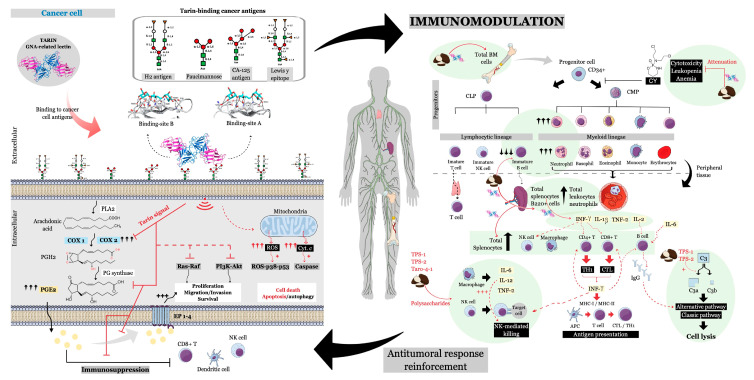Figure 4.
Hypothetical antitumoral tarin mechanism. (left-hand panel) Tarin binds to specific carbohydrate antigens, typically overexpressed in cancer cells, down-regulating COX-2 (cyclooxygenase 2) expression, culminating in decreased PGE2 (prostaglandin 2) synthesis and derepression of the antitumoral response. Tumor progression can be inhibited by inactivation of Ras–Raf or PIK3–Akt pathways and cell death by the activation of ROS-p38-p53 or caspase-dependent pathways, inducing apoptosis or autophagy, commonly described for GNA-related lectins. Red lines show already known tarin mechanisms. Dashed red lines indicate the main mechanisms reported for GNA-related lectins. PLA2—phospholipase A2; PG synthase—prostaglandin synthase; ROS—reactive oxygen species; Cyt. c—cytochrome c; EP1-4—prostaglandin E receptor 1-4; NK cells—natural killer cells. (right-hand panel) Anticancer effects may be boosted by the immunomodulatory abilities of tarin and other taro derivatives, whose effects are highlighted in green and include complement activation through alternative and classical pathways, natural killer (NK) cell activation, T cell activation to TCD4+ cells (Th1) and TCD8+ (CTLs—cytotoxic T lymphocytes) effectors, cytokines release by polysaccharide-activated macrophages and tarin-activated splenocytes, progenitor cell protection through the attenuation of cyclophosphamide (CY) cytotoxic effects and the proliferation of spleen and bone marrow cells. Red lines indicate tarin and polysaccharide effects, while the dotted red lines indicate the downstream effects that might be triggered by released cytokines. CLP—common lymphoid progenitor, CMP—common myeloid progenitor, BM—bone marrow.

